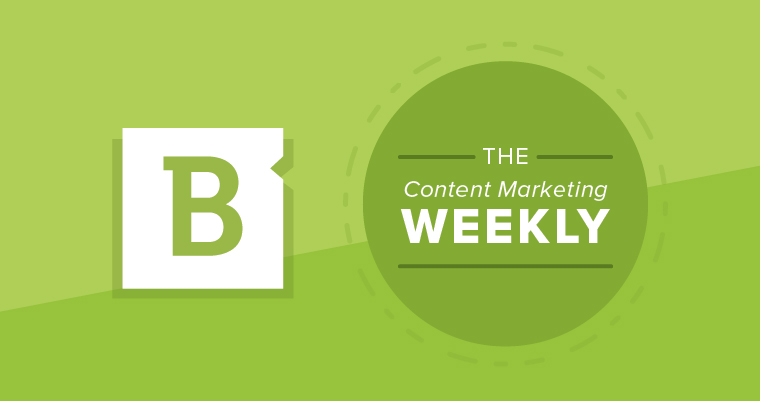The Content Marketing Weekly features the industry’s top news and updates. This week we have huge martech growth forecasted, ineffectual PPC habits and algorithmic changes that are forcing marketers to pivot.
Not quite a Thanksgiving buffet, but you get the point.

Marketing Technology Budgets Will See Double-digit Growth Next Year, According to New Report
If you’re a digitally savvy consumer or even a perpetually online workaholic, it’s nearly impossible to give up your tech gadgets cold turkey. And it will become harder to do so in the future.
That’s because advertisers and marketers are pumping even more money into their technology budgets in 2018. Forrester is predicting double-digit growth in martech spend next year, as seen in this article in AdWeek, and the primary driver of this allocation is customer experience.
#CX in 2020? 7 #technology trends defining the future of #CustomerExperience. (#AI #AR #VR #UX #IoT #Fintech) https://t.co/6AH6GRpOPt pic.twitter.com/e9WqxWv1bi
— Mike Quindazzi ✨ (@MikeQuindazzi) November 16, 2017
At the end of the day, everyone is a consumer, everyone is a customer, and we all want information, products and services on-demand. Companies that are hesitant to finance technology of their own will have to rely more heavily on the likes of Amazon and Apple as platforms for customer engagement. But without a meaningful platform or interactive component of their own, marketers are just feeding the growth of the aforementioned tech monoliths, not necessarily investing in more native solutions.
Are You Changing Keyword Bids too Often?
Marketers under the gun to hit quarterly quotas feel the pressure increase as the fiscal calendar turns over. Those managing AdWords accounts and PPC campaigns may, then, feel the need to closely monitor their keyword bidding strategies on a daily or even hourly basis, grossly neglecting other job functions.
And for what?
Good question. Search Engine Land walks through the risks of frantic keyword bidding and discusses how much attention marketers should actually be giving to the more manual tasks of chasing higher ad positions.
It can be more stressful than Thanksgiving dinner at the in-laws, to say the least.
One big problem is that if a keyword is not super competitive, there is little data to show performance regardless (aka there’s no need to hover over your monitor devising new bidding schemes).
Additionally, when people do nothing, they feel like they’re accomplishing nothing. But depending on your market and your keywords, doing nothing can still yield wins.
As a general barometer, companies that sell high-price, low-volume products should probably tweak their keyword bids once a month or quarter. Conversely, low-price, high-volume markets require weekly or monthly adjustments.
The majority of your time should be spent analyzing data on bidding, positions, conversions and spend, not on changing bids every day.
Your Brand vs Social Algorithms: The Conundrum of 2018
If you’ve spent months or even years crafting the most foolproof content strategy sure to set the marketing world ablaze, it may have been for naught.
Don’t look so sad, it’s almost Black Friday.
But it’s true. As this article in Marketing Land explains, algorithms change quickly and often without warning. That means social strategies, specifically, can be upended overnight.
The major social media platforms recently moved away from chronological ordering of posts, so timing is not necessarily a great way to grab attention or catch new followers – it’s all about relevance to a specific user. More recently, Twitter doubled its character limit. So much for your quippy commentary on IoT – you’re now competing against 280 characters of detailed analyses on the same subject. Whose Twitter posts will perform better?
The answer is, “No one knows just yet.”
And that’s the key. Manage these known unknowns as best as you can and don’t place too much emphasis on cute algorithmic tactics that could be obsolete come the weekend. Know your customers and serve them experiences that entertain and inform. It’s the best we can do.
4 Ways Instant Gratification Has Changed Content Marketing
Our brains are hardwired to seek pleasure and avoid pain. And, man, there’s some painful content marketing out there.
That gives you the opportunity to satisfy user intent and provide pleasant customer experiences through your marketing (kind of like hosting Thanksgiving dinner and leaving guests with full bellies). To accomplish this, we must look at users through the prism of instant gratification.
This Entrepreneur article looks at how content marketing has changed to match the evolving demands of finicky online users.
Accommodating these folks means utilizing Google AMP, personalizing content through data and understanding prospects like never before. Key initiatives for marketers to make headway on starting now are:
- Optimize everything for social.
- Preview formatted content and tweak before publishing – preview screens are the first impression you make for users quickly scrolling through news feeds.
- A/B test through Google Optimize 360.
- Increase conversions through real-time data with Adobe Target.
On to December!





